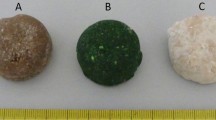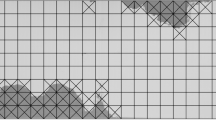Abstract
Dead neonatal mice are currently used as bait for delivery of toxin to invasive brown treesnakes (Boiga irregularis) on Guam; once deployed in the field the mice are highly attractive to the snakes but only for about four days. An artificial bait containing a mixture of fats mimicking those in skin of the mice is also highly attractive to the snakes and remains attractive 2–3 times longer. The artificial bait, however, costs more than the mice, and is more difficult to attach to the capsules of a novel aerial bait delivery system. This paper describes a reformulation of the bait which reduced the ingredient cost to 11% of its former value, without compromising its attractiveness to free-ranging snakes. Three lipid formulations using different source materials to produce the same fatty acid profile target were tested along with two levels of pork fat to yield six test formulations. No differences in bait disappearance were noted in field testing of the baits, indicating that decisions regarding bait formulation could be made on the basis of cost without sacrificing efficacy. Separately, testing of 17 commercially available adhesives identified five for field testing. Among these, two demonstrated strong, weather-resistant bonds between the oily surface of the artificial baits and the bait capsules as evidenced by only 13.4% and 4.5% of baits falling off suspended capsules. Importantly, neither of these adhesives impacted bait removal by snakes in field trials in comparison to baits with no adhesive.. The results represent an advance in technology development for landscape-scale suppression of brown treesnake populations.





Similar content being viewed by others
Data availability
The datasets generated during and/or analyzed during the current study are available from the corresponding author on reasonable request.
Notes
Brown Tree Snake Control and Eradication Act of 2004, Pub. L. No. 108-384 Section 7, 118 STAT. 2224 (2004).
Duncan Hunter National Defense Authorization Act for Fiscal Year 2009, Pub. L. No. 110-417 Section 316, 122 STAT. 4410 (2008).
References
Clark L, Clark C, Siers S (2017) Brown tree snakes: methods and approaches for control. In: Pitt WC, Beasley J, Witmer GW (eds) Ecology and management of terrestrial vertebrate invasive species in the United States. CRC Press, London
Engeman RM, Shiels AB, Clark CS (2018) Objectives and integrated approaches for the control of brown tree snakes: an updated overview. J Environ Manag 219:115–124. https://doi.org/10.1016/j.jenvman.2018.04.092
Freedman MG, Miller RH, Rogers HS (2018) Landscape-level bird loss increases the prevalence of honeydew-producing insects and non-native ants. Oecologia 188:1263–1272. https://doi.org/10.1007/s00442-018-4273-5
Fritts TH, Rodda GH (1998) The role of introduced species in the degradation of island ecosystems: a case history of Guam. Annu Rev Ecol Syst 29:113–140. https://doi.org/10.1146/annurev.ecolsys.29.1.113
Johnston JJ, Savarie PJ, Primus TM et al (2002) Risk assessment of an acetaminophen baiting program for chemical control of brown tree snakes on Guam: evaluation of baits, snake residues, and potential primary and secondary hazards. Environ Sci Technol 36:3827–3833. https://doi.org/10.1021/es015873n
Kimball BA, Stelting SA, McAuliffe TW et al (2016) Development of artificial bait for brown treesnake suppression. Biol Invasions 18:359–369. https://doi.org/10.1007/s10530-015-1031-z
Krause MA, Burghardt GM (2001) Neonatal plasticity and adult foraging behavior in garter snakes (Thamnophis sirtalis) from two nearby, but ecologically dissimilar, habitats. Herpetol Monogr. https://doi.org/10.2307/1467039
Moore A, Jackson T, Quitugua R et al (2015) Coconut Rhinoceros Beetles (Coleoptera: Scarabaeidae) Develop in Arboreal Breeding Sites in Guam. Florida Entomologist 98:1012–1014. https://doi.org/10.1653/024.098.0341
Pollock HS, Fricke EC, Rehm EM et al (2020) Såli (Micronesian starling-Aplonis opaca) as a key seed dispersal agent across a tropical archipelago. J Trop Ecol 36:56–64. https://doi.org/10.1017/S0266467419000361
Provenza FD (1995) Tracking variable environments: There is more than one kind of memory. J Chem Ecol 21:911–923. https://doi.org/10.1007/BF02033798
Rodda GH, Savidge JA (2007) Biology and Impacts of Pacific Island Invasive Species. 2. Boiga irregularis, the Brown Tree Snake (Reptilia: Colubridae)1. Pasc 61:307–324
Savarie PJ, Clark L (2006) Evaluation of bait matrices and chemical lure attractants for brown tree snakes. Proc Vertebr Pest Conf. https://doi.org/10.5070/V422110077
Savarie PJ, Shivik JA, White GC et al (2001) Use of acetaminophen for large-scale control of brown treesnakes. J Wildl Manag 65:356–365. https://doi.org/10.2307/3802916
Siers SR, Shiels AB, Barnhart PD (2020) Invasive Snake activity before and after automated aerial baiting. J Wildl Manag 84:256–267. https://doi.org/10.1002/jwmg.21794
Siers SR, Shiels AB, Payne CG et al (2019) Photographic validation of target versus nontarget take of brown treesnake baits. Wildl Soc Bull 43:752–759. https://doi.org/10.1002/wsb.1023
Vice DS, Engeman RM, Vice DL (2005) A comparison of three trap designs for capturing brown treesnakes on Guam. Wildl Res 32:355–359. https://doi.org/10.1071/WR04046
Vice DS, Pitzler ME (2002) Brown treesnake control: economy of scales. In: Human conflicts with wildlife: economic considerations. Proceedings of the Third NWRC Special Symposium. National Wildlife Research Center, Fort Collins, Colorado, USA
Acknowledgements
These studies were made possible through funding provided by the U.S. Department of the Navy (MIPR# M2002118MPDP075) and generous access to Andersen AFB. This research was supported in part by the intramural research program of the U.S. Department of Agriculture, Animal and Plant Health Inspection Service and Agricultural Research Service. The assistance of USDA APHIS Wildlife Services staff located on the island of Guam was greatly appreciated. Editor: Please include this statement. “Mention of trade names or commercial products in this publication is solely for the purpose of providing specific information and does not imply recommendation or endorsement by the U.S. Department of Agriculture. USDA is an equal opportunity provider and employer”
Funding
Information that explains whether and by whom the research was supported: Funding provided by the U.S. Department of the Navy (MIPR# M2002118MPDP075).
Author information
Authors and Affiliations
Corresponding author
Ethics declarations
Conflict of interest
The authors declare that they have no conflict of interest.
Consent for publication
All authors have consented to publication of this manuscript.
Ethics approval
Include appropriate approvals or waivers: NWRC protocol QA-3011 (“Artificial Toxic Bait Attachment and Field Stability for Landscape-scale Brown Treesnake Suppression”) was approved by the Institutional Animal Care and Use Committee on 10/10/19.
Additional information
Publisher's Note
Springer Nature remains neutral with regard to jurisdictional claims in published maps and institutional affiliations.
Rights and permissions
About this article
Cite this article
Garcia, R.A., McAuliffe, T.W., Bumanlag, L.P. et al. Adaptation of an artificial bait to an automated aerial delivery system for landscape-scale brown treesnake suppression. Biol Invasions 23, 3175–3185 (2021). https://doi.org/10.1007/s10530-021-02567-8
Received:
Accepted:
Published:
Issue Date:
DOI: https://doi.org/10.1007/s10530-021-02567-8




